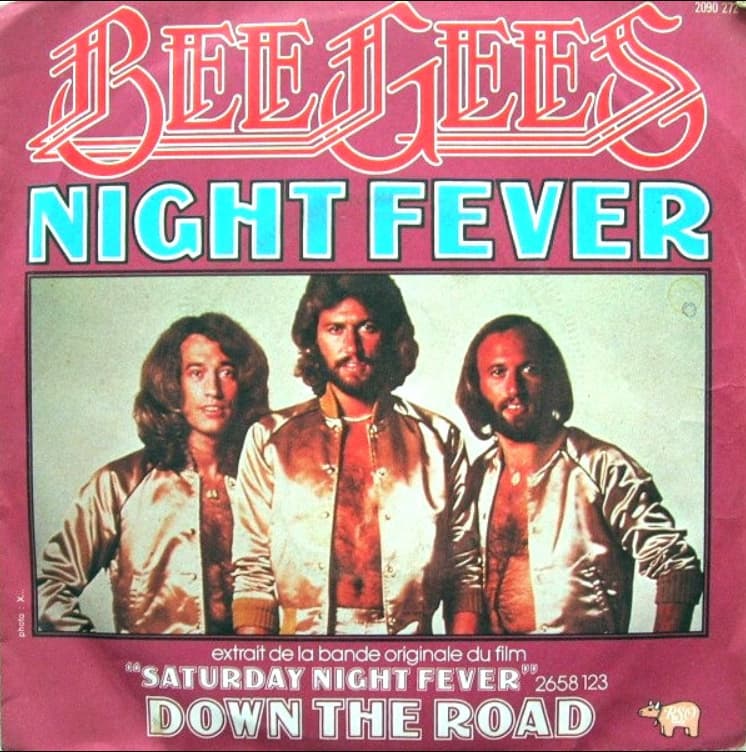
“Night Fever” by Bee Gees: A Disco Era Masterpiece
“Night Fever” is a song that not only defines the Bee Gees‘ career but also encapsulates the essence of the disco era. Released as part of the Saturday Night Fever soundtrack, this song became an anthem for the late 70s, capturing the energetic and infectious spirit of the time. The Bee Gees, consisting of Barry, Robin, and Maurice Gibb, were already riding high on the success of their previous hits when “Night Fever” was released, but this track cemented their status as disco legends.
Upon its release, “Night Fever” quickly climbed the Billboard Hot 100, debuting at an impressive #76 before making a significant leap to #32. Its ascendancy continued as it moved through the ranks to #17, then #8, #5, and finally reaching #2. It wasn’t long before it claimed the top spot, where it remained for an impressive eight weeks, the longest for any single that year. Remarkably, during the first five weeks that “Night Fever” was at #1, another Bee Gees hit, “Stayin’ Alive,” was holding strong at #2. This dominance was a testament to the band’s unparalleled influence on the music scene at the time.
The inspiration and creation of “Night Fever” is a story of creative synergy and serendipity. When Bee Gees manager Robert Stigwood was producing a film about the New York disco scene, he initially wanted to name it “Saturday Night.” However, the Bee Gees had already penned a song called “Night Fever” and were adamant that it would make a better title for the movie. They managed to convince Stigwood, leading to the iconic title “Saturday Night Fever.”
The song’s distinctive string intro was inspired by “Theme from A Summer Place” by Percy Faith, as recounted by keyboardist Blue Weaver. He was experimenting with the melody when Barry Gibb overheard it and immediately saw its potential. This moment of inspiration led to the creation of the unforgettable hook that defines “Night Fever.” The lyrics, completed by Barry, Robin, and Maurice Gibb, were written in a spontaneous session on a staircase, echoing the band’s earlier creative processes.
Recording for “Night Fever” began in April 1977 in France and was completed by September of the same year. The Bee Gees approached the recording with their characteristic attention to detail, starting with the rhythm and gradually layering in the electric piano, bass, and heavy guitar parts. The production, led by Albhy Galuten, ensured that the song had the perfect blend of disco beats and smooth falsetto vocals, elements that defined the Bee Gees‘ sound.
Critics and fans alike praised “Night Fever” for its infectious energy and polished production. Billboard highlighted its “jumping disco beat” and “smooth falsetto lead,” while Cash Box noted its “dancin’ beat, scratchy guitar, sweeping orchestration, and familiar falsetto.” Record World confidently predicted its success as another dance hit for the Bee Gees.
The legacy of “Night Fever” extends beyond its chart success. It replaced Andy Gibb‘s “Love Is Thicker Than Water” at number one and was succeeded by Yvonne Elliman‘s “If I Can’t Have You,” both of which were also written and produced by the Gibb brothers. This string of hits showcased the brothers’ unparalleled songwriting prowess. “Night Fever” was the third of six consecutive US #1s for the band, tying them with The Beatles for the most consecutive #1 singles.
Billboard ranked “Night Fever” as the No. 2 song for 1978, behind Andy Gibb‘s “Shadow Dancing.” In the UK, it topped the Singles Chart for two weeks, further solidifying its place in music history. The song has appeared in various films, including Mystery Men, Luna, and Mr. Saturday Night, and remains a staple on disco playlists worldwide.
“Night Fever” is more than just a song; it’s a cultural milestone that captures the zeitgeist of the disco era. Its enduring popularity is a testament to the Bee Gees‘ talent and their ability to create music that resonates across generations.